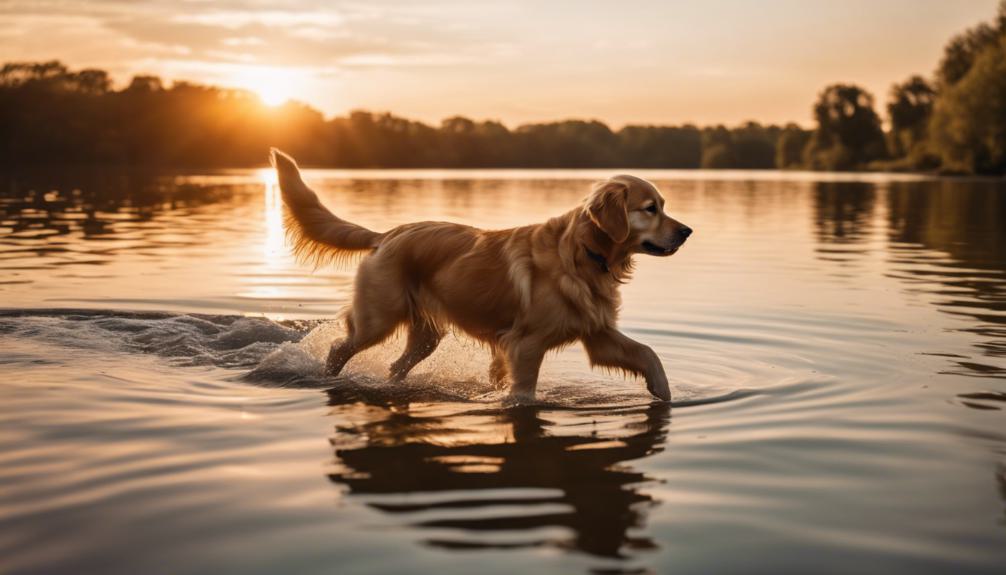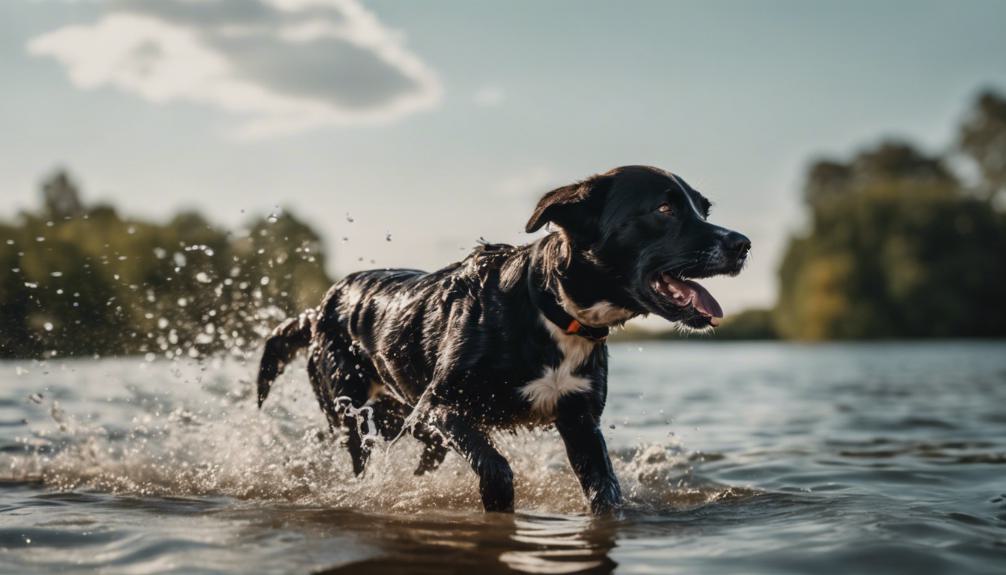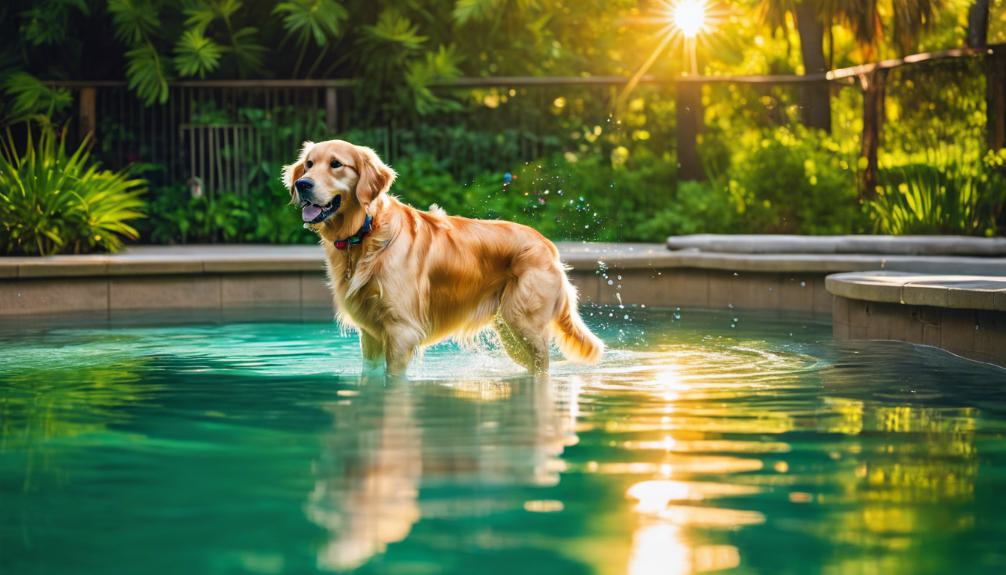How to Train Your Dog to Swim? Water-Loving Pup Tips
To train your water-loving pup to swim, start with shallow waters and use positive reinforcement like treats and toys. Begin with simple water games to create positive associations, then gradually introduce deeper areas. Establish a safe and supportive environment, supervising closely and using a life jacket if needed. Celebrate progress and provide encouragement to build confidence. Keep a consistent schedule, increasing difficulty slowly while monitoring safety throughout. For more tips on training your dog to swim successfully, focus on gradual introductions, positive reinforcement, and ongoing safety precautions. Your pup will soon be paddling like a pro!
Importance of Swimming for Dogs
Swimming is an essential activity for dogs, providing numerous physical and mental health benefits. To teach your dog to swim effectively, it’s important to introduce them to the water gradually in a controlled environment. Positive reinforcement, such as treats and praise, can help your furry friend associate swimming with a positive experience.
The water’s buoyancy supports their movements, making it an ideal exercise for dogs with joint issues or arthritis. Overweight dogs can also benefit from swimming, as it helps them burn calories and improve fitness levels without putting excessive stress on their bodies.
Additionally, regular swimming sessions can enhance your dog’s mental well-being by offering mental stimulation and reducing anxiety. Start slowly and patiently guide your dog into the joys of swimming for a healthier and happier companion.
Choosing the Right Swimming Location
Why is selecting a suitable swimming location important when teaching your dog to swim? Here are some essential considerations to keep in mind:
- Look for a safe and calm environment, like a shallow pool or calm lake, to make the experience enjoyable for your dog.
- Choose a location with easy entry and exit points to help your dog feel more at ease in the water.
- Avoid areas with strong currents or waves that could overwhelm your dog during their swimming lessons.
- Consider using water toys or a designated dog swimming area to encourage your dog while ensuring the location is safe for humans too.
Introducing Your Dog to Water

To acclimate your dog to water gradually, consider incorporating fun and engaging activities that build positive associations with aquatic environments. Start by playing games of fetch in the grass to introduce the concept of retrieving objects near water. Use a kiddie pool with a toy to create excitement and positive associations with water play. Additionally, incorporate a sprinkler to familiarize your dog with water splashing and encourage exploration. Finally, gradually shift to the big pool with a splash ledge to help your dog feel more comfortable in deeper water. Remember, close supervision with a 1:1 people-to-pup ratio is essential to provide support and guidance during the introduction to water activities.
| Activities | Benefits |
|---|---|
| Games of fetch | Introduces retrieving near water |
| Kiddie pool with toy | Builds positive water associations |
| Sprinkler play | Familiarizes with water splashing |
| Shift to big pool | Helps in deeper water comfort |
Positive Reinforcement Techniques
When teaching your dog to swim, remember to use treats for motivation and consider incorporating clicker training benefits. Rewarding your furry friend with treats or praise when they make progress in the water can help create a positive association with swimming.
Positive reinforcement techniques, like enthusiastic praise and rewards, will encourage your dog to build confidence and enjoy their swimming lessons.
Treats for Motivation
Using high-value treats like small pieces of chicken or cheese is an effective way to motivate your dog during swimming training. To guarantee successful training, keep in mind the following:
- Reward your dog promptly with treats after they display the desired behavior in the water.
- Treats can help establish positive associations with swimming, making it an enthusiastic activity for your pup.
- Consistent treat rewards can enhance your dog’s confidence and enthusiasm for swimming sessions.
- Generosity with treats can create a strong connection between swimming and enjoyable experiences for your furry friend.
Clicker Training Benefits
Clicker training improves your dog’s swimming abilities through the use of a small device that marks desired behaviors with a distinct sound. This positive reinforcement technique helps your dog associate the sound with a reward, making learning more effective and enjoyable.
The precise timing of marking correct behaviors during swimming lessons is essential, as it allows for clear communication between you and your pup. By consistently using the clicker and rewarding your dog, you can help them understand and excel in swimming skills.
Additionally, positive reinforcement techniques like clicker training not only aid in skill development but also strengthen the bond between you and your furry companion, fostering trust and cooperation.
Gradual Depth Increase Training

When training your dog to swim, it’s essential to start in shallow waters and gradually increase the depth. This gradual progression helps build your dog’s confidence in the water.
Remember to use positive reinforcement, like treats and toys, to motivate your furry friend as they explore deeper waters.
Shallow Water Introduction
Begin by easing your dog into swimming in shallow waters, gradually increasing the depth to boost their confidence. Here’s how to help your furry friend get comfortable with the water:
- Start in Shallow Waters: Begin in a safe and shallow area where your dog can touch the bottom.
- Build Confidence: Slowly increase the depth as your dog gets more comfortable, praising and rewarding them for their progress.
- Positive Reinforcement: Use treats, toys, or verbal praise to encourage your dog to explore deeper waters.
- Provide Support: Be there to support your dog physically and emotionally, ensuring they feel safe and secure in the water.
Slow Depth Progression
To help your dog gradually acclimate to deeper waters, focus on incrementally increasing the depth during their swimming training sessions. Start training in shallow water and slowly deepen the level as your pup gains confidence.
Use positive reinforcement like treats and toys to motivate them to swim in deeper areas. It’s important to provide support and supervision as your furry friend progresses to higher depths. Allow your dog to get comfortable at each new level before moving on to the next.
Monitor their comfort and progress closely to guarantee a successful and enjoyable swimming experience. By following this gradual progression and closely monitoring your dog’s development, you can help them become a skilled swimmer in deeper waters.
Monitoring Safety While Swimming
Monitor your dog’s safety by closely watching them while they swim. To guarantee a safe swimming experience, follow these guidelines:
- Supervise: Keep a close eye on your dog at all times to prevent accidents.
- Life Jacket: Consider using a life jacket, especially for beginner swimmers or those in open water.
- Water Quality: Check the water quality before letting your dog swim to avoid any health issues.
- Toxic Algae: Be cautious of toxic algae blooms, as they can be harmful to your dog’s health.
Building Confidence in the Water

To build your dog’s confidence in the water, start with basic land activities like games of fetch. Playing on solid ground can help your pup feel comfortable and confident before introducing them to the water.
Once your furry friend seems at ease, consider setting up a kiddie pool with a favorite toy inside. This can create excitement and positive associations with water. Additionally, using a sprinkler can be a fun way to familiarize your dog with water splashing around them.
Gradually moving to a larger pool with a splash ledge can help your pup feel secure in the water. Remember to always conclude each swimming session on a positive note to boost your dog’s confidence and enjoyment of swimming.
Consistent Practice and Encouragement
For successful dog swimming training, maintain consistent practice and provide encouraging feedback to your furry companion. Here are some tips to keep in mind:
- Keep a Regular Schedule: Set aside dedicated time for swimming practice to help your dog get accustomed to the water.
- Encourage with Treats and Praise: Use positive reinforcement like treats and verbal praise to motivate your pup during swimming sessions.
- Gradually Increase Difficulty: Start with simple water activities and slowly introduce more challenging exercises to build your dog’s confidence.
- Provide a Supportive Environment: Guarantee the swimming area is safe and comfortable for your dog, creating a positive experience that encourages learning and progress.
Frequently Asked Questions
How Do You Train a Puppy to Swim?
To train a puppy to swim, start slow with a kiddie pool and a toy. Use treats and praise to build excitement. Increase water depth gradually and offer support. Supervise closely and make it a positive experience.
What Is the Best Age to Teach a Dog to Swim?
To teach a dog to swim, consider breed, personality, and vet guidance. Start with water introductions in a tub, using toys. Wait if unsure about timing. Gradual, patient steps are essential for a positive experience at the right age.
How Can I Improve My Dog’s Swimming?
To improve your dog’s swimming, start with shallow water, use positive reinforcement like treats, and provide supervision. Gradually increase depth, make it fun, and consider a flotation vest for safety. With patience, support, and practice, your pup will swim like a pro!
How Do I Get My Dog to Like the Baby Pool?
Introduce a kiddie pool with a toy to spark your dog’s curiosity. Have fun with fetch near the pool to make it exciting. Use interactive toys and a sprinkler for gradual exposure. Reward positive interactions to boost their confidence.
Conclusion
Training your dog to swim is a rewarding experience that can provide them with both physical and mental stimulation. By following the tips outlined in this article, you can help your water-loving pup become a confident swimmer.
Remember to choose the right location, use positive reinforcement techniques, and always prioritize safety.
With consistent practice and encouragement, your furry friend will soon be splashing around with joy in the water. Happy swimming!

